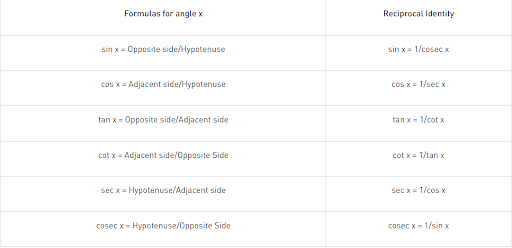If $\tan 15^{\circ}+\frac{1}{\tan 75^{\circ}}+\frac{1}{\tan 105^{\circ}}+\tan 195^{\circ}=2 a$, then the value of $\left(a+\frac{1}{a}\right)$ is :
- 4
- 2
- $4-2 \sqrt{3}$
- $5-\frac{3}{2} \sqrt{3}$
The Correct Option is A
Approach Solution - 1
We are given the equation:
\[ \tan 15^\circ + \frac{1}{\tan 75^\circ} + \tan 105^\circ + \tan 195^\circ = 2a. \]
Step 1: Simplify the Individual Terms
We know that:
- \(\tan 15^\circ = 2 - \sqrt{3}\),
- \(\frac{1}{\tan 75^\circ} = \cot 75^\circ = 2 - \sqrt{3}\),
- \(\tan 105^\circ = \cot 75^\circ = -\cot 75^\circ = -2 + \sqrt{3}\),
- \(\tan 195^\circ = \tan(180^\circ + 15^\circ) = \tan 15^\circ = 2 - \sqrt{3}\).
Step 2: Substitute into the Equation
Substituting these values into the equation:
\[ (2 - \sqrt{3}) + (2 - \sqrt{3}) + (-2 + \sqrt{3}) + (2 - \sqrt{3}) = 2a. \]
Simplify the left-hand side:
\[ 2 + 2 - 2 + 2 - \sqrt{3} - \sqrt{3} + \sqrt{3} - \sqrt{3} = 2a, \]
which simplifies further to:
\[ 4 - 2\sqrt{3} = 2a. \]
Step 3: Solve for \(a\)
Dividing both sides by 2:
\[ a = 2 - \sqrt{3}. \]
Step 4: Calculate \(a + \frac{1}{a}\)
Now we calculate:
\[ a + \frac{1}{a} = (2 - \sqrt{3}) + \frac{1}{2 - \sqrt{3}}. \]
To simplify \(\frac{1}{2 - \sqrt{3}}\), rationalize the denominator:
\[ \frac{1}{2 - \sqrt{3}} \times \frac{2 + \sqrt{3}}{2 + \sqrt{3}} = \frac{2 + \sqrt{3}}{(2 - \sqrt{3})(2 + \sqrt{3})}. \]
The denominator simplifies as follows:
\[ (2 - \sqrt{3})(2 + \sqrt{3}) = 4 - 3 = 1. \]
Thus:
\[ \frac{1}{2 - \sqrt{3}} = 2 + \sqrt{3}. \]
Step 5: Combine the Results
Now substitute back into the expression for \(a + \frac{1}{a}\):
\[ a + \frac{1}{a} = (2 - \sqrt{3}) + (2 + \sqrt{3}) = 4. \]
Therefore, the value of \(a + \frac{1}{a}\) is 4.
Approach Solution -2
\(tan15^∘=2−\sqrt3\)
\(\frac1{tan75^∘}=cot75^∘=2−\sqrt3\)
\(\frac1{tan105^∘}=cot(105^∘)=−cot75^∘=\sqrt3 −2\)
\(tan195^∘=tan15^∘=2−\sqrt3\)
\(∴2(2−\sqrt3 )=2a\)
\(⇒a=2−\sqrt3 \)
\(⇒a+\frac1{a}= \frac{2-\sqrt3 }1 + \frac1{2-\sqrt3 } =\frac{8-4\sqrt3 }{2-\sqrt3 }\)
\(=\frac{8-4\sqrt3 }{2-\sqrt3 } \times \frac{2+\sqrt3 }{2+\sqrt3 }= \frac{4}1\)
\(=\) \(4\)
Therefore, The correct answer is option (A) : 4
Top Questions on Trigonometric Functions
- Solve for \( x \), \[ 2 \tan^{-1} x + \sin^{-1} \left( \frac{2x}{1 + x^2} \right) = 4\sqrt{3} \]
- CBSE CLASS XII - 2025
- Mathematics
- Trigonometric Functions
- Evaluate: $ \tan^{-1} \left[ 2 \sin \left( 2 \cos^{-1} \frac{\sqrt{3}}{2} \right) \right]$
- CBSE CLASS XII - 2025
- Mathematics
- Trigonometric Functions
- The graph of a trigonometric function is as shown. Which of the following will represent the graph of its inverse?

- CBSE CLASS XII - 2025
- Mathematics
- Trigonometric Functions
- The integral \[ \int_0^\pi \frac{8x}{4\cos^2 x + \sin^2 x} \, dx \text{ is equal to:} \]
- JEE Main - 2025
- Mathematics
- Trigonometric Functions
- The value of \( \cos \left( \sin^{-1} \left(-\frac{3}{5}\right) + \sin^{-1} \left(\frac{5}{13}\right) + \sin^{-1} \left(-\frac{33}{65}\right) \right) \) is:
- JEE Main - 2025
- Mathematics
- Trigonometric Functions
Questions Asked in JEE Main exam
- A group 15 element forms \( d\pi - d\pi \) bond with transition metals. It also forms a hydride, which is the strongest base among the hydrides of other group members that form \( d\pi - d\pi \) bonds. The atomic number of the element is ________________________.
- JEE Main - 2025
- Chemical bonding and molecular structure
- The value of \( (\sin 70^\circ)(\cot 10^\circ \cot 70^\circ - 1) \) is:
- JEE Main - 2025
- Trigonometric Identities
- Match List-I with List-II.

- JEE Main - 2025
- Dimensional analysis
Nature of compounds TeO₂ and TeH₂ is___________ and ______________respectively.
- JEE Main - 2025
- Inorganic chemistry
- Let \( A = [a_{ij}] \) be a matrix of order 3 \(\times\) 3, with \(a_{ij} = (\sqrt{2})^{i+j}\). If the sum of all the elements in the third row of \( A^2 \) is \( \alpha + \beta\sqrt{2} \), where \(\alpha, \beta \in \mathbb{Z}\), then \(\alpha + \beta\) is equal to:
- JEE Main - 2025
- Matrices and Determinants
Concepts Used:
Trigonometric Functions
The relationship between the sides and angles of a right-angle triangle is described by trigonometry functions, sometimes known as circular functions. These trigonometric functions derive the relationship between the angles and sides of a triangle. In trigonometry, there are three primary functions of sine (sin), cosine (cos), tangent (tan). The other three main functions can be derived from the primary functions as cotangent (cot), secant (sec), and cosecant (cosec).
Six Basic Trigonometric Functions:
- Sine Function: The ratio between the length of the opposite side of the triangle to the length of the hypotenuse of the triangle.
sin x = a/h
- Cosine Function: The ratio between the length of the adjacent side of the triangle to the length of the hypotenuse of the triangle.
cos x = b/h
- Tangent Function: The ratio between the length of the opposite side of the triangle to the adjacent side length.
tan x = a/b
Tan x can also be represented as sin x/cos x
- Secant Function: The reciprocal of the cosine function.
sec x = 1/cosx = h/b
- Cosecant Function: The reciprocal of the sine function.
cosec x = 1/sinx = h/a
- Cotangent Function: The reciprocal of the tangent function.
cot x = 1/tan x = b/a
Formulas of Trigonometric Functions:
